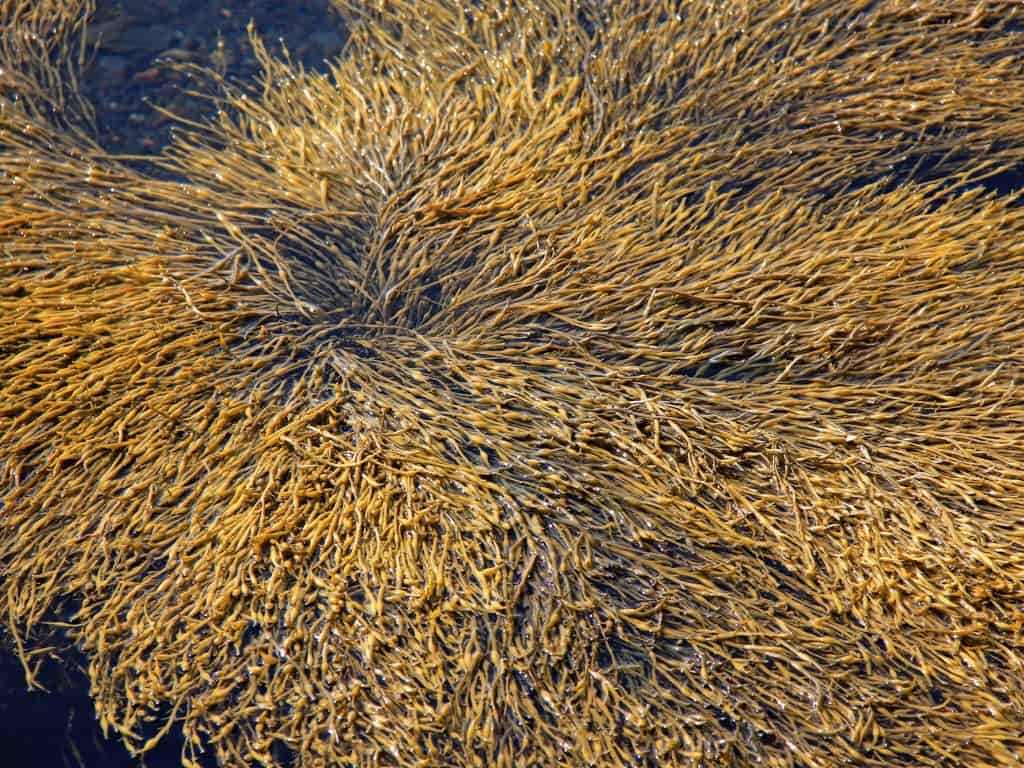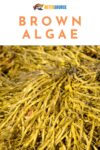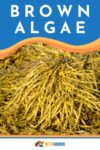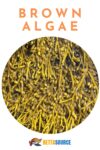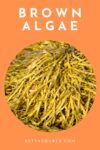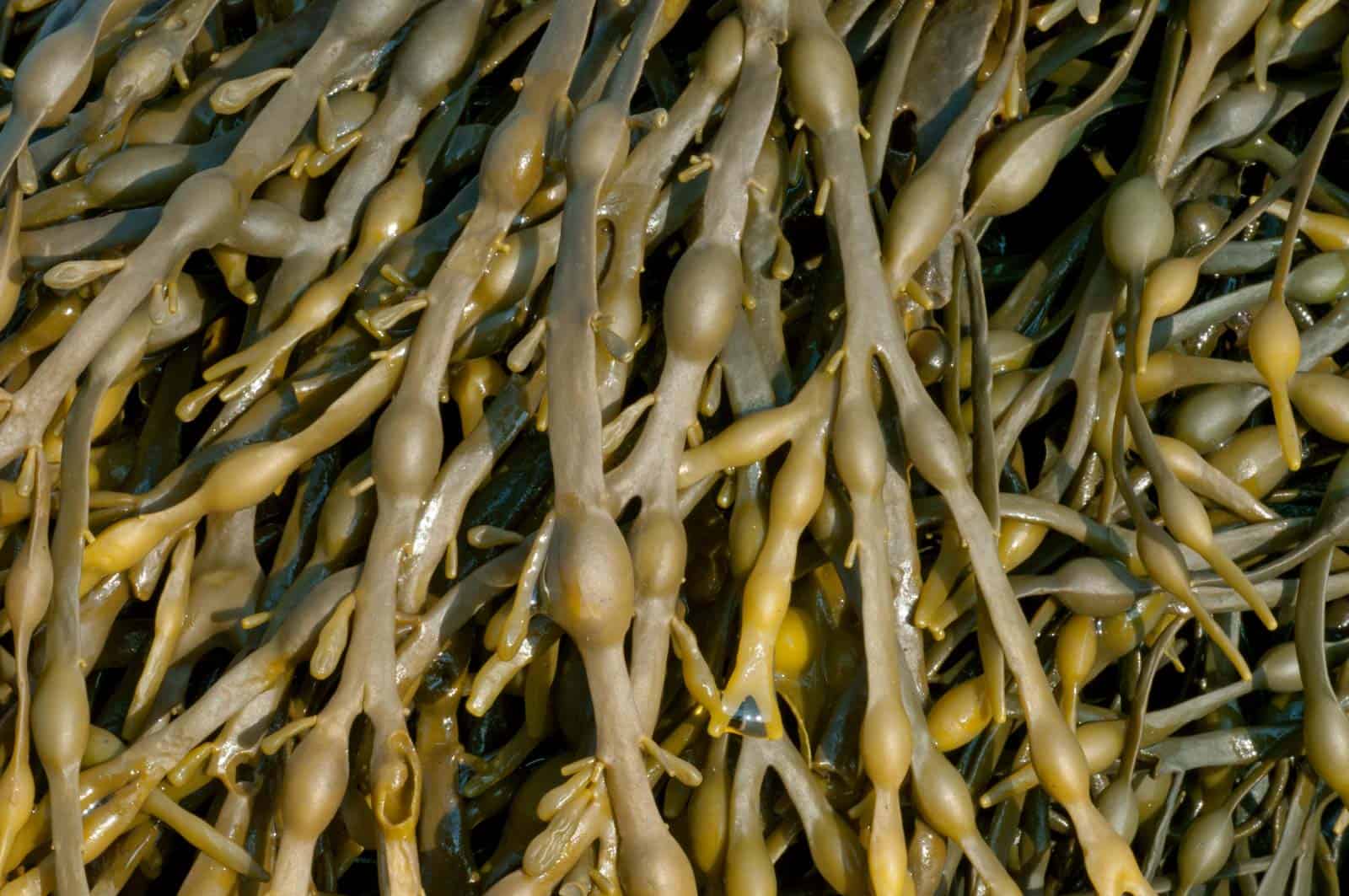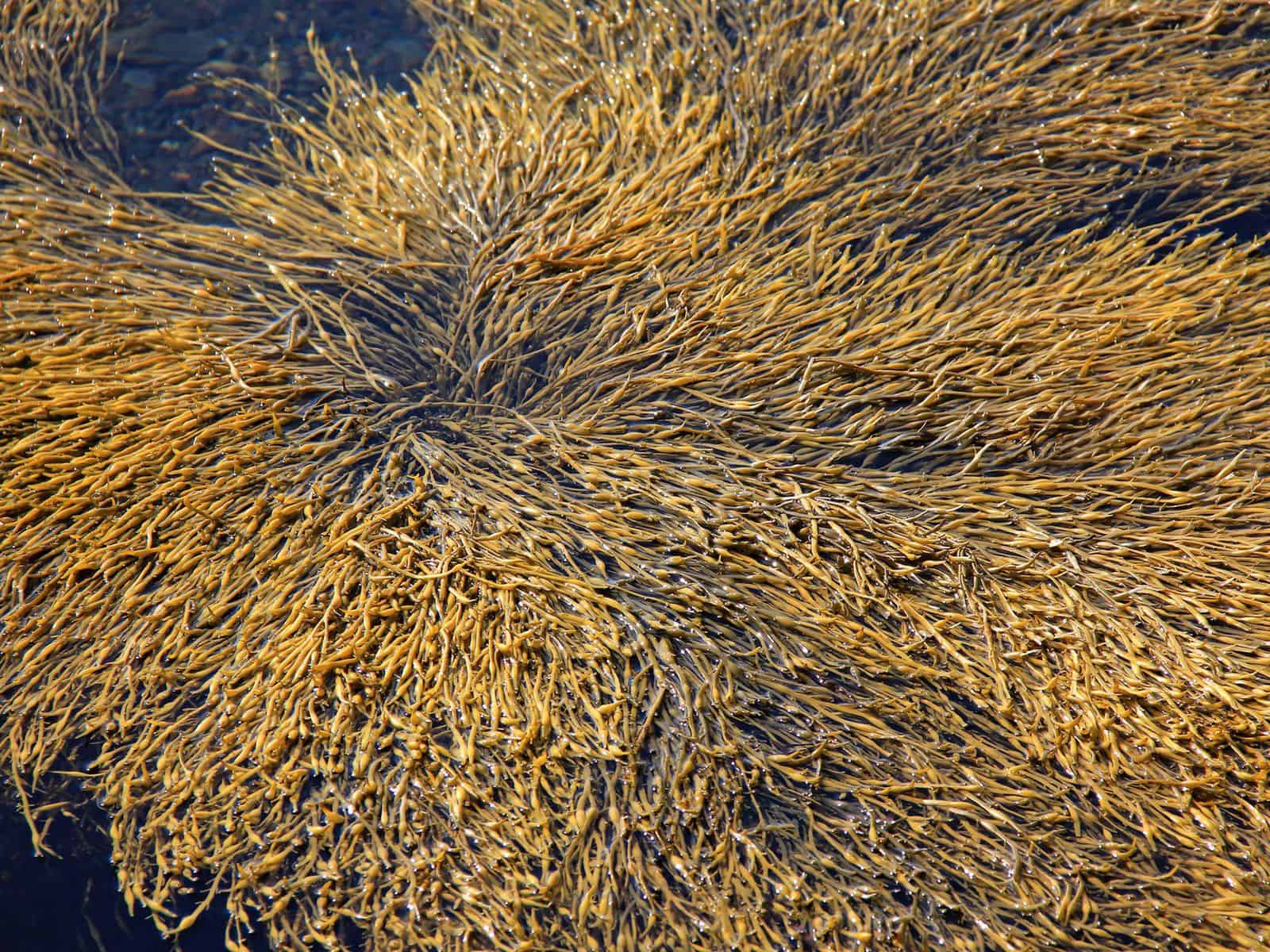If you’re starting to notice a brown haze to the glass of your aquarium or on the leaves of your live plants, you might be dealing with a brown algae outbreak.
Algae is the last thing most hobbyists want to hear about or see, but even the healthiest and most thriving tanks usually have algae; algae is as much a part of the ecosystem as carefully-chosen live plants are! Unfortunately, algae tend to be ugly and can overtake live plants and other aquarium decorations if not maintained.
Keep reading to find out everything you need to know about brown algae, what causes it, and how to remove brown algae from your betta aquarium!
What are brown algae?
Algae can be very difficult to identify and most species need a microscope to be able to correctly identify the exact kind you’re dealing with. Luckily, most algae can be grouped together into eight main categories: diatoms, green algae (Chlorophyta), Euglenophyta, Dinoflagellata, golden algae (Chrysophyta), red algae (Rhodophyta), brown algae (Phaeophyta), and blue-green algae (Cyanobacteria; under classification reassessment as blue-green algae has been found to be prokaryotic while all other algal groups are eukaryotic). For brown algae, we will specifically be looking at diatoms and Phaeophyta.
Diatoms
Diatoms are found in both freshwater and saltwater ecosystems and are responsible for generating most of the atmospheric air available on Earth. There are an estimated 20,000-2,000,000 different species which all play an integral part in specific food webs and contribute half of the organic material found in the ocean. They provide information about the present and past water qualities and conditions as they can only grow in a very specific and ideal range of parameters and can be used to monitor changing environments. But if they’re so beneficial to so many ecosystems, why are they a problem in the aquarium system?
Diatoms are single-celled algae with cell walls made out of silica making them resemble little jewels when placed under a microscope. They are mainly photosynthetic and fossil records date their origins back nearly 200 million years. Planktonic diatom movement is mostly dictated by water currents but heavier species are able to attach to surfaces like substrate, plants, and rocks.
In the aquarium, all diatoms are collectively referred to as brown algae. This is because diatoms will appear as a brown, rusty coating that overtakes most surfaces of the aquarium. Most often, brown algae will show up in the system several weeks or months after having set up the aquarium.
What is silica?
Silica is silicon dioxide (SiO2), which is a result of when silicon bonds with oxygen. Silica is the main component of sand in many parts of the world and also makes up quartz. It is not known exactly how diatoms integrate silica into their outer casings, but it serves as a protective barrier from predators and other viruses and microbes.
Phaeophyta
Phaeophyta is true brown algae but mostly appears in marine systems and will not be a concern for your betta tank. These multicellular algae are most abundant in the cooler waters of the Northern Hemisphere and can grow as small tufts or as complete kelp forests; this alga gets its name from its consistent brown colorings, with reds and yellow intermixed.
What causes brown algae (diatoms)?
Since Phaeophyta is most abundant in marine ecosystems, we will only focus on what causes brown algae (diatoms) in the aquarium and how to remove it from your system.
Causes for brown algae
Brown algae natural occurs in aquarium systems and should be expected to pop up at one time or another throughout the tank’s life. However, if brown algae appear past the first six months after setting up your aquarium, there might be an underlying issue in your system.
New tank
Brown algae is very likely to show up in your tank during a cycle. If bacteria haven’t had time to efficiently establish itself in your tank yet, brown algae might flourish first with the availability of extra nutrients, like silica and nitrate, that isn’t being taken up otherwise.
Once bacteria populations start to catch up with nutrient inputs, the brown algae should naturally start to subside and will leave the tank on its own; other algae will then usually take its place.
Tap water and water changes
If you’re still experiencing brown algae months after you set up the tank, it might have to do with your water source. Water changes help remove waste from the aquarium while introducing and replenishing beneficial trace elements that help keep your system running. This is why it is important to know exactly what is in your water so that you know what is going into and being removed from your aquarium.
For both freshwater and saltwater aquariums, it is always recommended to use RO water (reverse osmosis water) or distilled water; both these options have been purified to different extents to remove most unwanted nutrients and elements. Both RO water and distilled water can easily be found at your local supermarket or convenience store and are relatively cheap in comparison to the headaches that you could face down the line using imperfect water.
Most beginner hobbyists are under the impression that tap water and/or regular bottled water is fine for their aquarium as long as they use a water conditioner. Unfortunately, this is wrong and usually causes problems that can lead to bigger problems due to there being unknowingly high concentrations of silica.
In order to know exactly what is in your tap water/bottled water, the water must be sent out to a laboratory to undergo an ICP analysis (Inductive Coupled Plasma) which uses wavelengths to determine elements and their respective concentrations. If this sounds pricey to you, it is; this process can also take several weeks to get results back, which can cause a lot of damage to your aquarium in the meantime.
Perhaps you are using RO water or distilled water and brown algae keeps popping up in your aquarium despite regular water changes and tank maintenance. You might not think of it, but make sure that your hands and forearms are completely clean when working on your tank. Many lotions and creams contain silica which can easily leak into the aquarium during water changes.
When I work on my tank, I make sure to run my hands and forearms underwater for at least a couple of minutes, scrubbing vigorously until any sliminess has been washed off. I then dry my hands completely and feel to check if there is any remaining sliminess or other smell from chemicals or food; if there’s any trace, I wash my hands and forearms again.
Substrates
One of the things you might not think about as a problem is your substrate, especially if it was marked as aquarium safe. While this is pretty unlikely to happen as most hobbyists have found silica-containing substrates to work just as well as others, it is not something you should entirely overlook.
As we mentioned before, silica is the main component of most sand found around the world. If the silica content of your substrate is especially high, it could be fueling brown algae to grow. You may also experience brown algae in your tank if you have recently changed the substrate.
Light and nutrient imbalances
While silica is the main catalyst behind brown algae blooms, it is only what keeps brown algae growing. Brown algae will also appear if there is an excess of nutrients in the fish tank. Like other algae, brown algae also need most of the major nutrients, like nitrate and phosphate, in order to sustain itself. If there is also an available source of silica, brown algae will grow until those resources have been depleted.
While nitrates and phosphates should always be present in aquarium systems, too much of each can lead to brown algae blooms and even worse algae that are more difficult to remove from the tank. Excess nitrates and phosphates could possibly be a result of overcrowding, overfeeding, poor filtration, poor water flow, or anywhere in between.
There is some debate about whether brown algae thrive in low light conditions or high light conditions. The theory is that brown algae thrive in low light conditions because it is able to take up nutrients faster than the live plants in your aquarium can when in subdued lighting. Others believe that since brown algae are photosynthetic, it thrives under more intense lighting as it can produce food faster and thus, reproduce more.
How to get rid of brown algae
The good news is that brown algae usually leave aquarium systems all on its own. As we mentioned before, most new tanks will see a brown algae outbreak at some point throughout its first few months. However, if brown algae just don’t seem to want to leave your fish tank, it may be time to find a way to remove it manually, through the addition of livestock, or through filtration and chemical means.
Are brown algae bad for your aquarium?
Some algae can be bad for the fish tank; some dinoflagellates can quickly reproduce and become toxic to aquarium fish while other thick and bushy algae can overgrow plants, causing them to be cut off from light and gas exchange. Thankfully, brown algae are usually nothing to worry about and will not result in dead fish or plants; it can just be a little ugly and annoying to have to deal with in your fish tank!
However, the human consumption of organisms, like shellfish, that have been subjected to or that have ingested an excessive amount of brown algae (diatoms) can lead to amnesic shellfish poisoning.
Manual removal
Luckily, it is pretty easy to manually remove brown algae from your fish tank if you don’t want to wait for it to leave on its own. It would be best to carry out the following suggestions while performing a water change to prevent pieces of algae from circulating around the tank:
In order to remove brown algae from the walls of your tank, simply use a magnetic cleaner, sponge, or paper towel to wipe off brown areas; always use a new sponge or one that has been dedicated to your fish tank to prevent cross-contamination! To remove brown algae from your substrate, use an aquarium vacuum to filter out the algae and any other detritus that may have gotten buried; it is recommended to continue regularly vacuuming your substrate during water changes to prevent dead zones and other algae growth even when the brown algae has been removed.
To remove brown algae from your aquarium plants and decorations, it is recommended to remove the items from the tank. In another bucket or container filled with used aquarium water, use a toothbrush or sponge to gently remove the algae. Once the pieces have been scrubbed, place them back into your tank and dispose of the used water; never use tap water for this process as this will lead to more silica entering your aquarium system!
Fish, snails, and other livestock
Unlike most other algae, brown algae are actually eaten by fish and snails! If you have an appropriately sized tank, a new addition could be the answer to eliminating brown algae from your aquarium.
Fish. One of the top fish to get rid of brown algae from your tank are dwarf suckers (Otocinclus). Otocinclus is a genus of catfish that only grow to be about 1 to 2 inches (3.8-5.0 cm). However, these fish do best when kept in schools of at least six or more and need lots of plants and places to hide.
In a community tank with peaceful fish, these fish can eliminate algae from your aquarium overnight! Because they are such voracious eaters, Otocinclus should only be placed in a mature and established fish tank that has enough surface area to grow adequate food. Even then, it is recommended to regularly offer algae wafers and blanched vegetables.
However, Otocinclus are not one of the best fish to keep with betta fish, especially if kept in a small tank. To find out why these fish don’t do well with betta fish, make sure to check out our guide on keeping betta fish with Otocinclus catfish here!
Snails. A much better alternative to the Otocinclus is keeping a snail with your betta fish. Snails are able to be kept in a smaller fish tank and you won’t have to worry about possible problems with aggression.
Hobbyists have had success with many different kinds of snails, like ramshorn snails (Planorbidae family) and nerite snails (Neritidae family). One of the big problems with keeping snails though is that they tend to reproduce and overpopulate the tank very fast. Nerite snails seem to be a little more popular of a choice as they need salt water in order to reproduce and for juveniles to grow; this makes the chances of overpopulating minimal.
Some hobbyists also recommend Amano shrimp if the tank allows; keep in mind that betta fish often see shrimp as a quick snack. It would be worthwhile to introduce additional hiding places throughout the tank if you’re planning on adding a shrimp.
Plants. It might seem counterintuitive, but plants will help outcompete pest algae species. Since they both use the same nutrients to grow, adding more plants will help take-up those important nutrients from the water before the algae can. Plants will also create natural hiding places throughout the aquarium and introduce more oxygen into the water by way of photosynthesis; plus, nothing looks more natural than a planted aquarium!
However, some bettas are more likely to nip at plants than others, and some especially like to go for the roots. If you have a betta with an appetite for some greens, it is recommended to plant shorter, hardier species instead, like Java moss (Taxiphyllum barbieri), Java fern (Leptochilus pteropus/Microsorum pteropus), Amazon sword (Echinodorus genus), and Anubias.
Filtration, media, and chemicals
Supplemental filtration, media, and chemicals should only be used as a last resort. If using additional filtration, media, or chemicals to help get rid of brown algae, you should also be trying to find the original source of the problem; until that problem is dealt with, your fish tank will continue to struggle with many different species of algae.
Filtration
If you aren’t able to keep up with the manual removal of brown algae and do not have the space to accommodate for an additional fish or snail, then your last resort might be using increased filtration or chemicals.
It is important to upkeep with regular aquarium maintenance to not only keep your tank clean and stable but also to ensure that all your equipment is working properly. One of the problems with scrubbing algae off surfaces within the tank is that little bits and pieces get left in the water column. Once you turn your equipment back on, this algae will most likely get sucked into your filter and caught in your filter media.
While this algae most likely won’t reproduce there due to lack of light, the filter can get clogged; this is especially important to consider if the equipment has a propeller that can easily get stuck. At the same time, the algae will start to decompose and can become a source of excess nutrients, like nitrates and phosphates, further promoting algae growth in the display aquarium.
It is recommended to clean all aquarium equipment at least every 6 months to check that it is still functioning correctly and isn’t clogged. This can be done by removing the piece from the tank and scrubbing it down in another bucket or container that has used aquarium water in it; using other water may result in beneficial bacterial dying.
In general, good water flow is a must in aquarium systems, with saltwater requiring more than freshwater. This is to help prevent dead zones from happening in the tank where detritus is free to pile up and release nutrients and promote algae growth. However, with bettas, adding additional flow can be difficult as too much water flow can cause them to get hurt. Try to position the filter and/or powerhead in a way that circulates all of the water throughout the tank but does not affect the swimming area of your fish; usually, it is best to aim the water flow around the back of the tank, behind plants and other decorations.
If you have a larger tank, it may even be worthwhile to purchase a UV sterilizer. UV sterilizers contain a light that emits certain wavelengths. These wavelengths are meant to destroy the cell walls of most algae, bacteria, viruses, and other microbes. However, they can be quite pricey and large and are really only beneficial for much larger systems; smaller betta tanks can usually be managed through a series of consistent water changes.
Media and chemicals
If you’ve tried absolutely everything and you still can’t get rid of the brown algae from your tank, then it may be time to introduce a chemical solution. This should be your absolute last option as chemicals will temporarily relieve the problem but may also cause other problems in the meantime.
Media. One of the best ways to combat brown algae is by removing silica from your water. Seachem PhosGuard Phosphate & Silicate Remover in Marine & Freshwater Aquariums is a proven product that quickly removes phosphate and silica from the water column. However, it should be noted that phosphate is a very important nutrient for plant growth and if used in excess, this product can deplete nearly all the phosphate from your tank. It is also not recommended to be used with buffered freshwater systems.
Chemicals. Many species of algae can be treated with hydrogen peroxide. In order to get rid of algae, it is recommended to either target-dose the hydrogen peroxide onto the algae when aquarium pumps are off, and/or to remove objects that have algae on them and do a hydrogen peroxide bath.
For other chemical solutions from name brands, Vibrant Liquid Aquarium Cleaner for Freshwater Tanks and Seachem Flourish Excel seem to help treat brown algae as well as most other algae species. Remember, if you choose to dose these chemicals into your fish tank, be checking for possible causes of the algae in the first place!
How to prevent brown algae
Brown algae are one of the most common algae you’re likely to come across when cycling a tank and cannot be prevented. The best way to get rid of it is by letting it run its course until it has depleted the available silica and excess nutrients. There are a few ways to make sure that brown algae never pops up in your tank again though!
Good aquarium husbandry. The secret to keeping a beautiful fish tank is time and devotion. When setting up a tank, expect to spend at least one to three hours every week doing water changes and adjusting various equipment. Regular water changes will help keep water parameters in check and at stable levels. Regular testing for parameters is also recommended, though a mature tank will tell you when something is wrong. Even a small betta fish tank will need to be regularly checked to make sure that conditions are ideal!
Good water. Good water is essential for a good tank ecosystem. Knowing what is in your water will help you know what is entering and leaving your aquarium system. Brown algae will appear in your betta tank if you use tap water or bottled water! Instead, try using distilled water or RO water to help keep unwanted nutrients out of your tank.
Water flow. This may be more difficult in betta tanks, but the water flow is still very important for preventing brown algae and other species from taking root in your tank. If possible, create good circulation throughout the tank by positioning equipment towards the back, away from the main swimming area of the fish.
Cleanup crew. Even for a betta tank, a cleanup crew of algae eaters is important. Snails and shrimp will help remove excess detritus that can quickly leak out nutrients that can lead to brown algae and other pest algae.
While Otocinclus will help remove brown algae from larger systems, these fish do not do well in betta tanks. However, there is one fish that can help keep your betta substrate and plants free from detritus so that brown algae can’t take root: Corydoras.
Corydoras also need to be kept in schools, but they tend to get along better with bettas as they are quite active when kept in larger numbers. One of the best Corydoras species for a betta is the pygmy cory (Corydoras pygmaeus), which stays under an inch (2.5 cm) long when fully grown! These tiny fish will scan your substrate for fallen food and other waste and help keep brown algae from showing up in your tank; just because they’re tiny does not mean that they can be placed in a 5 gallon (18.9 L) tank though. These fish will need at least a 10 gallon (38 L) tank.
Note: While Corydoras will help keep algae from appearing in your tank, they are not the best algae eaters and should not be used to help combat algae problems if they are already present.
Conclusion
Brown algae can definitely be a headache. It is likely to show up in new tanks, but just as quick to leave most of the time. If you’re finding that the brown algae in your tank just won’t leave, it may be time to manually remove some, get additional livestock, or add filtration, media, or chemicals. Once the brown algae have successfully be eliminated from the tank, it is important to keep it from coming back too!
If you have any questions about brown algae, are having a brown algae outbreak, or have had experience removing brown algae from your tank, don’t hesitate to leave a comment below!
